
Garden STEM at Home
STEM learning can happen anywhere! We invite you to explore our five weekly lessons below for opportunities to engage in STEM learning at home, at school, online, in your neighborhood – anywhere!
Each lesson is designed to use simple materials (or ingredients) that you will have readily at hand. If not, we encourage you to improvise! Enjoy our lessons? Share your work at home or school by tagging us on social media at #DallasArboretumSTEM or email us at social@dallasarboretum.org.
Week of December 14: STEAM Takover 2
For the last two weeks before holiday break, we’re doing a STEAM takeover. All lessons and activities can be used in the science, STEM or art classroom to reinforce science learning!

Blow Up a Butterfly!
Dick Blick’s Blow Up a Butterfly! lesson plan is an excellent opportunity to fine tune students’ observation skills, while also focusing on key elements of art.
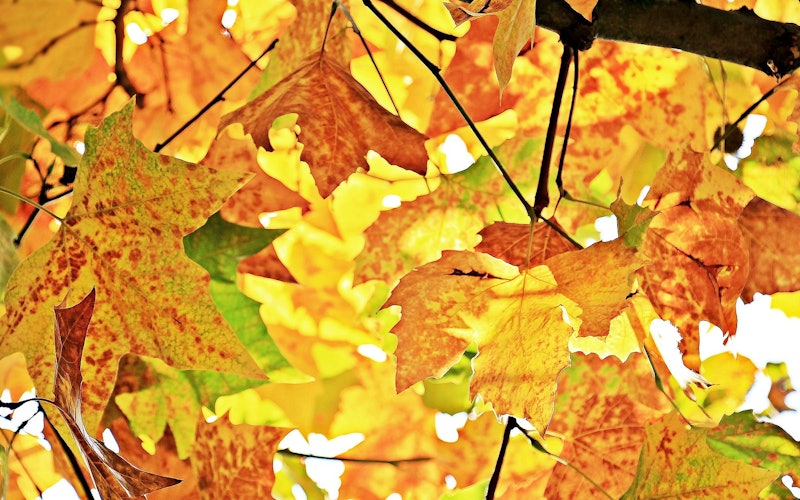
Book of Leaves
Dick Blick’s Book of Leaves lesson plan encourages kids to collect, preserve and “publish” a collection of leaves in a book.
This lesson represents an outstanding opportunity to explore a number of science topics, based on the age and grade level of your students. Check out the original lesson in the links below and see our recommendations for ways to align the activity to your classroom standards!

‘Mama’ Spider Sculpture
Dick Blick’s “Mama” Spider Sculptures lesson introduces students to the sculpture of French-born artist Louise Bourgeois. Created when Louise was in her 80s, the 30-foot-tall bronze spider named ‘Maman’ is an avante-garde masterpiece that is both compelling and frightening at the same time.
The Dick Blick lesson plan provides excellent instruction for creating three-dimensional sculpture, and we recommend using this lesson as a creative opportunity for students to demonstrate a variety of science learnings. Check out our recommendations below!

Matisse Prints du Soleil
Dick Blick’s Matisse Prints du Soleil lesson plan explores heliographic prints, a method that uses sunlight to dry portions of the print more quickly, thus allowing other colors, blocked by cut out shapes to flow into those areas. This is a scientific process known as diffusion.
This exciting, and often surprising, method of creating art can be used to highlight many different areas of science learning, so we invite you to explore our ideas below!

Painted Quilt Story
Dick Blick’s Painted Quilt Story lesson plan explores telling a story in a quilt, like American author and artist Faith Ringgold. Many students and teachers may be familiar with Ringgold’s classic illustrated book, Tar Beach, but many are surprised that she has produced art for decades, including quilts which tell stories through illustrations.
We recommend using this style for students to share their science learning for a variety of science topics. See our recommendations below.
Week of December 7: STEAM Takover

Very Veggie Guide
Print, illustrate and explore fruits and vegetables in our custom veggie guide. Take a tour of your refrigerator, pantry or grocery store with a whole new lens on learning!

Rose Journal
Winter rose blooms brighten up any garden – and ours you doing that right now in the garden!
Download our rose journal to learn new facts about a long-favorite plant, create your own illustrations and come see ours to brighten up a winter’s day.

Imagined Plants
Kids can demonstrate their knowledge of plant structures and functions in this creative lesson that asks them to imagine a whole new plant species!

Arp, Art & Intuition: Connections
Dick Blick’s Arp, Art & Intuition lesson plan ask students to explore abstract art through a lens of pioneer artist, Jean (Hans) Arp. Using pieces of string, kids create their own abstract shapes from which to build an art piece.
This activity can work with any science lesson, but could be particularly exciting as a method to display learning about food chains or food webs, life cycles or regular and repeating patterns. Download our connections lesson to see our suggestions on extensions for your science learners!

Assemblage Art
Dick Blick’s Assemblage Art lesson plan asks students to create new art from old things. Whether found, recycled or repurposed, the items used in assemblage art take on a new life through artful arranging and a solid color unification.
This art form can encourage students to think about everyday items in new ways and provides an opportunity to display science learning through art. Explore our suggestions below for including this project in your science content.
Week of November 30

Sound Map
We typically think of observations being what we SEE in the world around us. This activity asks participants to use another sense in an outdoor space by creating a sound map.
Settle into a familiar place, and experience it in a whole new way!

Structure & Function Walk
Plants, like all living things, have a variety of structures with specific functions to help them survive. A stem holds a plant upright towards sunlight. Roots allow nutrients from the soil to enter the plant.
In this activity, students will investigate some of the most common plants parts – roots, leaves, stems, flowers, fruit and seeds in a variety of locations to understand how humans’ use of plants varies.
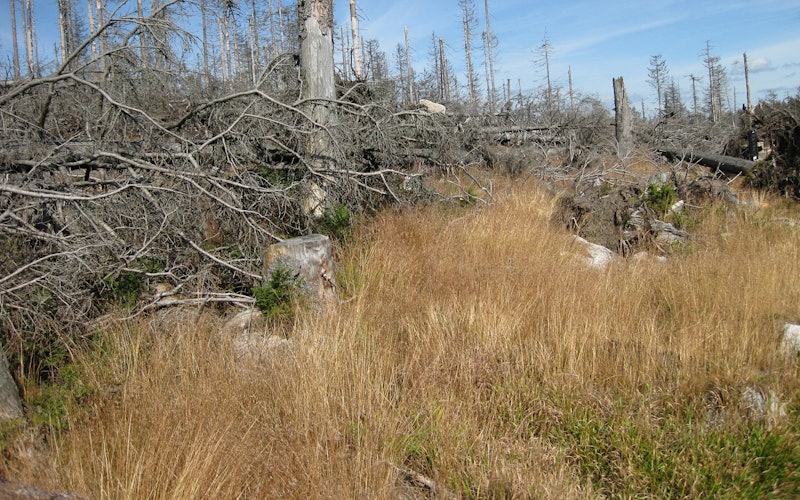
Trees in Trouble: Acid Rain
Many scientists believe that acidic precipitation, or acid rain, causes negative health effects on trees, and other vegetation. In this model, students will use white vinegar to simulate this effect with seedlings.

Rainy Day Hike
Some students may be familiar with the term watershed – or with pollution and runoff – but they may not make the connection that their schoolyard is, in fact, part of a larger watershed. In this activity, students will investigate their schoolyard, backyard or parking lot to examine how their environment plays a role in the watershed around them.
Week of November 16

BioRegional Quiz
When was the last full moon? Can you name three native mammals that live in your neighborhood? When is the frost date?
Building a sense of place is essential to science learning. We recommend starting with a bioregional quiz to explore your background knowledge and opportunities for further understanding.

Take a Hike
November 17 is National Take a Hike Day! You may think that you need to escape the city for a successful hike, but that is not the case at all!
Check out our resource guide that is perfect for hiking novices by sharing what to think about before your hike and activities and ways to engage with nature during your adventure.

Trees in Trouble: Crowding
Trees, like all plants, need space to grow so they can spread their roots and branches. In this demo,
students will model crowding by growing their own seeds.

Lights Out!
Much of the Dallas area rarely sees constellations at night – and even fewer people can name them! The truth is, this isn’t due to a lack of interest, but rather, the reality of light pollution in our modern world.
In this activity, students complete a light pollution audit and brainstorm ways to decrease light pollution and help wildlife.

Presto Pesto!
We’re back with another easy-to-follow (and easy-to-modify) recipe for kids to engage with: pesto!
Download the activity and recipe card and get grinding!
Week of November 9

Biodiversity Hunts
Kids love scavenger hunts! So, we’ve collected some of our favorites from this spring all into one download here – and they’re not just fun, they provide a great engaging activity to discuss a variety of life and earth science topics!

House Plant Journal
Scientific investigation is possible anywhere! Download our House Plant Journal to learn a bit about some of the most common house plants, sketch your own or take an adventure to view house plants at the library, an office building or even at a local store.
This journal is designed to be printed two-sided, but you can print one-sided to add more room for sketching!

Let’s Talk Turkey
The North American wild turkey has been existence for at least 10 million years! This bird has been an important source of food and clothing to indigenous people and continues to be a popular hunting species. It also is the genetic source of the domesticated turkey – which is drastically different in size and favor.
Let’s Talk Turkey serves as an excellent case study in the complicated relationship between society and natural resources.
Week of November 2

Insect Inspection
Insects include roughly one million species, living in every habitat found on the planet. All insects share the same basic features: a segmented body with three parts (head, thorax and abdomen), three pairs of jointed legs, antennae and compound eyes.
This activity introduces students to these commonalities and asks them to find examples in the wild.

Pond Life Cards
This activity features an artist’s rendering of a typical pond, along with cards for each living species found in the image. Sixteen task cards ask kids to think about the image and complete tasks, including creating a food web, sorting based on characteristics and considering the strengths and weaknesses of the model – plus more! This one is particularly aligned for 3rd-6th grade learners.
If you plan to print this one, choose two-sided, flipping on the long edge of the paper and you’re all set!

Cold Frames
North Texas is ideally situated for year-round gardening, but the addition of a cold frame can significantly improve your efforts.
This activity asks kids to explore a variety of options and design a cold frame of their choosing based on materials available and budget. It’s a great STEM challenge for your students or family!

Trees in Trouble
Just like other plants and animals, trees require plenty of water, nutrients, room to grow and a stress-free environment to flourish. If these needs are not met, a tree may grow slowly or even die.
This activity explores some common causes of troubled trees and invites kids to explore trees around their neighborhood or schoolyard.

One-Pot Meal
One-pot meals combine protein, vegetables and carbohydrates, and this type of meal has been around for millennia. Everyday staples from chili, tagine or posole to curry, Coq au Vin and pho are all classic examples of this cooking method.
This activity allows kids to use a simple formula to build their own one-pot wonders.
Week of October 26

Time Lapse
Ecological succession is the process in which an ecosystem changes and ages over time. This fairly predictable change is comparable to the stages of growth of a plant or animal, and is divided into two types: primary and secondary. In this activity, students will learn about both types and the typical species found in each.

Plant Cuttings: Super Rooters
Propagation is any method or process that grows new plants from a variety of sources, including seeds, cuttings and other plant parts.
Seeds are typically produced as a result of sexual reproduction. As a result, the genetic makeup of the resulting seed is a recombination of the contributing plants.
Cuttings, though, are a method of vegetative reproduction. This means the new plants are a clone of the single parent that contributed the cutting.
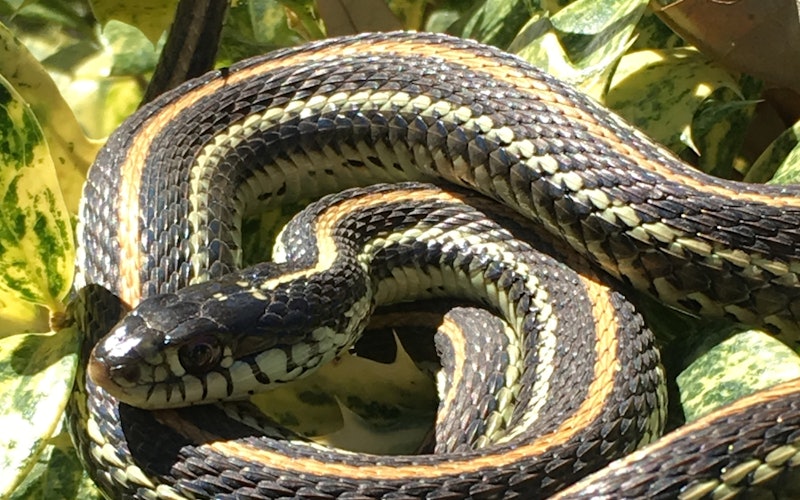
Career Critters
Sometimes, the ecological niche filled by specific plants and animals can be used to help solve human-induced environmental problems. Organisms can help mitigate problems – from erosion to garden vectors – just by doing their ‘jobs’. In this activity, we explore these ‘career critters’!

Bird Nest Bobble
How can you attract birds to nest in your backyard? Surprisingly, you don’t have to regularly feed them. If you have nice nooks in your trees – or even rafters above human reach – birds are likely to find your backyard a suitable habitat.
If you can provide an area of loose leaf litter and twigs in the garden, birds will readily use up these materials. But, if you prefer a more pristine look or have animals in the yard, a hanging nesting material bobble may be the perfect addition to your backyard.

Butter Investigation
In all likelihood, butter was an accidental invention some 8000 years ago when a nomadic traveler was carrying a bag of fresh milk in a sheepskin or stomach sack. This discovery quickly became a staple food of peoples working with ruminant animals – cows, goats, sheep, reindeer, camels and water buffalo all provided milk that could become butter.
While modern industrial dairies have perfected sweet cream butter, all dairy milks contain fat and can produce butter. This activity allows kids to experience firsthand what it takes – and which types of dairy work best.
Week of October 19

Pass the Plants, Please
People, and other animals, eat many different parts of plants – from roots (carrots, parsnips) to stems (green onions, asparagus) to leaves (lettuce) and fruits (apples, tomatoes, etc.). While most parts of plants are eaten by something, this isn’t always the case. Even plants with edible parts may contain other parts that are poisonous.
This activity engages kids in exploring what plant parts they eat each week.

A Maze-ing Light
What do plants need to grow? Essential to all plants is light. This classic experiment allows students to visually see the powerful effect of light on plants.
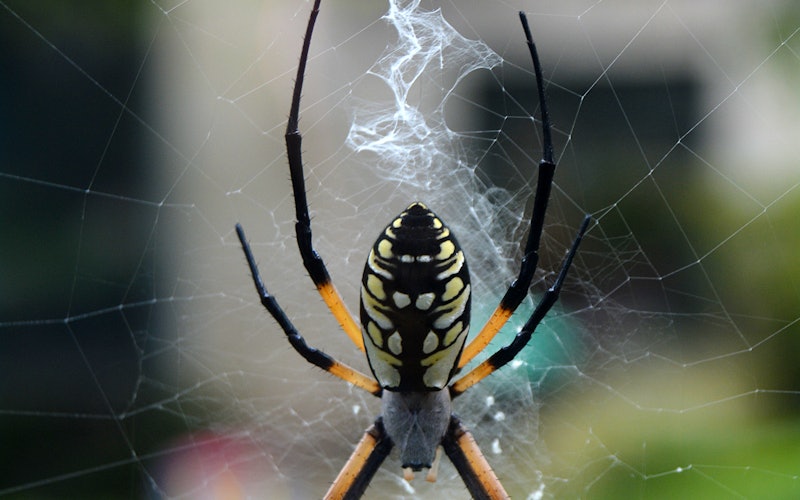
Interview a Spider
What is your first reaction when you see a spider?
Most people think of mammals and birds as wildlife, but wildlife also includes an incredible diversity of fish, reptiles, amphibians, insects, spiders, worms and other invertebrates. Focusing on some of these overlooked groups of wildlife, will help students understand and appreciate conservation on a habitat or ecosystem level.

A Peek at Packaging
Virtually everything we buy comes in some sort of package – or is shipped to the store in packaging. Packaging can be made from a wide variety of renewable and nonrenewable resources, depending on the purpose of the packaging.
This activity asks students to evaluate packaging sourced from their own homes.

DIY Seed Tape
Many common vegetable seeds are quite small. Homemade seed tape makes for easy planting, as well as great mini lesson on the space requirements of seedlings.
Week of October 12

Columbian Exchange
European contact with the Americas ignited a cultural exchange with long-lasting effects. In today’s activity, we ask students to explore some of the plant crops that found their way into global distribution as a result.
Each plant card contains facts about the crops origin, historical data and unique facts. Students engage with the cards using prompts, which include sort, discussion and further research.
(Print cards two-sided, flipping on the short edge.)
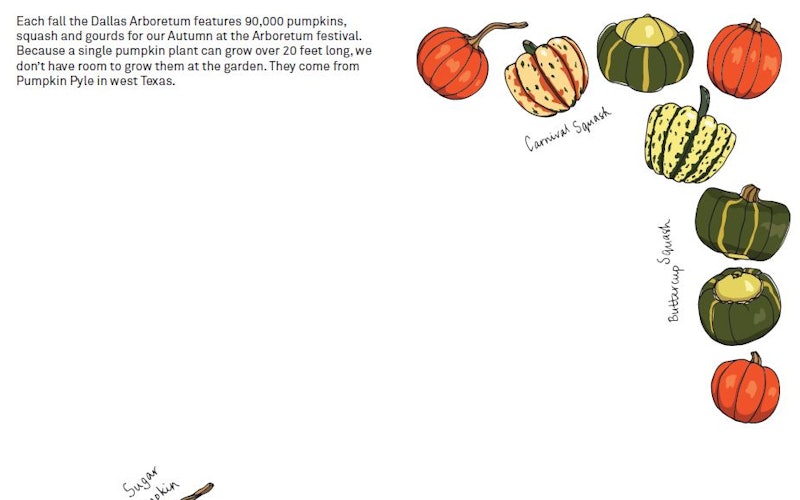
Squash Journal
Each fall, the Dallas Arboretum is transformed by 90,000 pumpkins, squash and gourds! We celebrate Autumn at the Arboretum with this downloadable journal for kids (and parents). We invite you to practice your skill at drawing our dozens of unique varieties while you learn a few more interesting facts about our favorite fall fruits!

Rapid or Slow: A Game on the Go!
Today’s activity asks kids to explore their knowledge of rapid and slow changes to the Earth. Can you draw a mudslide? Can you act out a delta?
Download our gameboard (11×17) and instructions and gamecards (8.5×11, double-sided, flip on long edge) to get started.
The game is great for review – or for practice while learning these essential Earth science standards!

First Impressions
People respond to different animals in a variety of ways. Sometimes, their reaction is based on fear, such as with spiders or snakes. People’s first reaction may even be to harm the creature, yet many spiders and snakes are completely harmless to people.
Different backgrounds, both personal and cultural, can result in people viewing animals in quite different ways. While bats may cause fear for some, they are viewed as a sign of good luck in China.
In this activity, students discuss their first impressions and then learn more about a species of their choosing.

Salsa Math
Salsa originated with the Inca people, and upon European contact with the Americas, it was consumed as a condiment amongst not only the Inca, but also the Aztec and Maya peoples. Originally a combination of tomatoes, chiles and ground squash seeds, it was served to Aztec lords on turkey, venison, lobster or fish. The name originates with Alonso de Molina in 1571.
Salsas are a great opportunity for kids to practice mixing and balancing the four basic flavors: sweet, sour, salty and bitter.
Week of October 5

Environmental Exchange Box
Every region is home to uniquely adapted plant and animal species that call it home. Many native species have also found their way into regional products, like maple syrup or pecan treats. In this activity, students learn about life in another region of the state or country.

Garden Scavenger Hunt
All gardens – whether native plants or vegetables – are closely tied to the landscape in which they are located. The plants that grow, their seasonal changes and whether they thrive all depend on a number of environmental factors and on the biotic and abiotic factors present. In this activity, kids become more acute observers of the world just outside their door.

The Fallen Log
Dead or dying wood is home to a plethora of living organisms. From the moss, lichens and fungi that sprout on bark to termites, sow bugs and other scavengers that eat the wood, a rotten log is full of life. In this activity, kids explore life in, on and below a fallen log.

Every Drop Counts
Dead or dying wood is home to a plethora of living organisms. From the moss, lichens and fungi that sprout on bark to termites, sow bugs and other scavengers that eat the wood, a rotten log is full of life. In this activity, kids explore life in, on and below a fallen log.
Week of September 28

Can It Be Real?
Adaptation is the result of the combined effects of variation and natural selection. Over the course of millennia, this has resulted in spectacularly unique adaptations. In this activity, kids will explore some of those unique adaptations!

Looking at Leaves
The shape and size of leaves varies greatly and can provide great clues to the identity of the tree from which it fell. In this activity, students explore trees in their backyard, schoolyard or nearby park.

Are Vacant Lots Vacant?
Many children are surprised to learn that areas humans wouldn’t call home are often perfectly suitable habitats for other living organisms.
A vacant lot, school garden or even a parking lot can provide an opportunity for kids to explore ecological relationships and habitats.

Invasive Species
Native species are plants or animals that occur naturally in a certain area. Typically, they have evolved alongside other species that naturally keep their population in check through predation, competition and disease.
In this activity, students explore what invasive species are, why they are problematic and how to prevent their spread.

Vermiculture
One oft overlooked step in the food chain is decomposition. Decomposers like pill bugs, earth worms and fungus are essential: they eat, digest and excrete dead plant material, returning nutrients back to the soil for reuse by living plants.
Vermiculture, or the cultivation of earthworms, is a hands-on way to see decomposition in action, to limit food scraps in landfill waste and to explore habitats.
Week of September 21

Picture This!
A key skill for young scientists is the ability to classify information. This activity asks students to classify native Texas wildlife based upon measurable criteria, such as number of legs, skin covering (fur, feathers, scales), size or how they move. In this activity, students will practice their skills using photos of native Texas wildlife, including plants and animals.

Seed Need
Most animals are well-adapted to resource scarcity; they can move! Plants, though, don’t have that choice. In order to ensure their survival, plants must depend on other methods. One of the most popular is seed dispersal. In this activity students will explore how mother plants disperse seeds.

Schoolyard Safari
A habitat is where an organism lives. While habitats can vary greatly in size and location, each habitat must provide an organism the same basic elements: food, water, shelter and space.
Often, students picture an ocean, a forest or a pond as a habitat, but careful observation can highlight that habitats are found just about everywhere!

Forest for the Trees
The United States is home to over 700 million acres of forestland, a full third of the total land base of the country. These forests are managed by three types of groups: public agencies, forest industries and private families.
Privately owned forests are managed with different objectives in mind – lumber, wildlife protection, soil erosion control and recreation are just some of these uses. In this activity, students take on the role of landowner and forest manager.

Dressing by Design
Oil and vinegar have been used to dress salad greens since Babylonian times (over 2000 years ago). What started as a home recipe has resulted in significant commerce. By the year 2000, over 140 million American households used ranch dressing!
Salad dressings main flavors are salty and sour, with fat helping to coat the bitter leaves. This lesson, adapted from Slow Food USA connects kids to the pleasures of healthy and delicious food.
Week of September 14
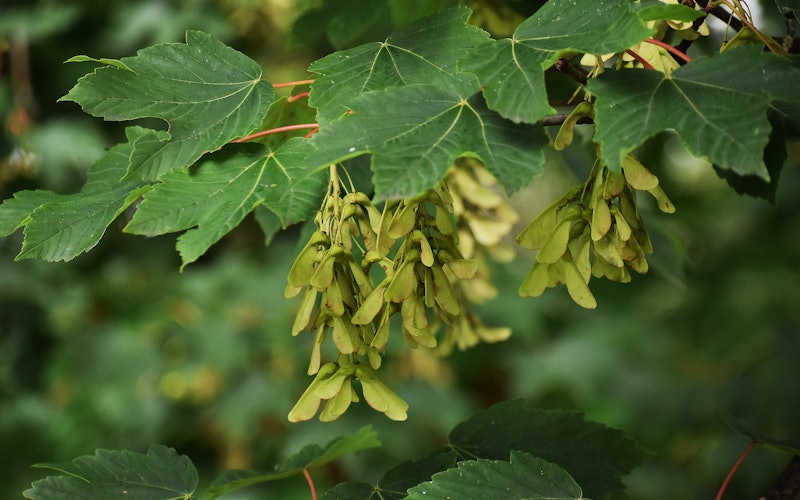
Get in Touch with Trees
Scientific exploration is largely based on utilizing our senses. This sensory lesson, which uses mystery boxes, provides an engaging sensory experience to do initial learning on any topic. For today’s lesson, the focus is on exploring trees!

Adaptation Artistry
All life forms are adapted to the specific environment they call home. These adaptations – from the spines on a cactus to the shape of a bird’s beak – are the result of unique conditions in a specific habitat. In this activity, students will design and construct their own bird, uniquely adapted for a specific habitat.

How Plants Grow
Plants are systems! They need sunlight, water, air, nutrients and space to grow. In this activity, kids explore the basic needs of plants and what happens when those needs are not met.

Urban Nature Search
Cities are not just homes for people. They provide habitats for a rich array of plants, animals and other living organisms. In this activity, students investigate that everyday areas, including parking lots, vacant lots and neighborhood parks are wildlife habitats.
Previous Content
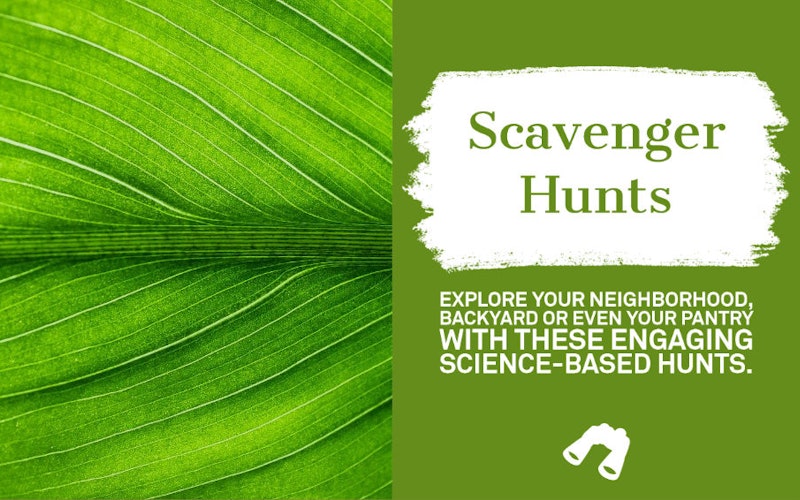

Backyard Scavenger Hunt
Explore living things in your own backyard! First, complete our scavenger hunt. Then show what you know:
K-2: Label each organism as living or non-living, and as plant or animal.
3-5: Draw a food chain using at least one organism from the scavenger hunt. Then, label each component as producer or consumer, and predator or prey.
6-8: Share the scavenger hunt with someone younger than you and then illustrate a food web that could be found in your back yard, the local park or even your parking lot!

Texture Scavenger Hunt
Have you ever noticed how some rocks are very smooth but other rocks are rough? Or that the vein pattern on leaves can look very different on different plants?
Well, today’s activity is all about exploring texture in your yard and neighborhood.
If you need some help identifying the vein patterns on leaves, we recommend you start here. Then, download the scavenger hunt and you’re off!
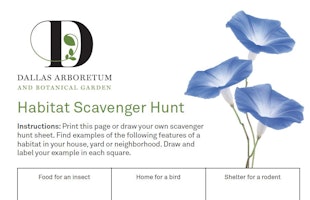
Habitat Hunt
This week, we’re back with another look at habitats. How do you know if a spider lives in your bushes? How do you know if a dandelion can survive in that crack in the sidewalk?
In our Habitat Scavenger Hunt, we ask you to explore your house or apartment, yard, driveway or neighborhood to find elements of a habitat for different plants and animals.

Edible Plant Parts
This week we’re back with another scavenger hunt that has you looking for edible plant parts.
Can you complete all the squares using your kitchen? How about your backyard or neighborhood?
For an extra challenge, try to find one example inside and one example outside for each!

Find & Draw 1
We’re back with another scavenger hunt to complete in nature – your backyard, your parking lot or your neighborhood! This time, after your complete your hunt, return home to add as much detail to your sketch as possible.
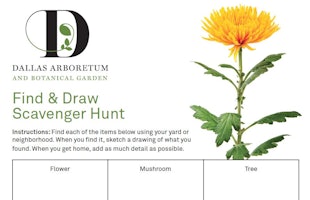
Find & Draw 3
Our Friday scavenger hunt will have you looking high and low, near and far. Can you complete each square as a scientific illustration labeling as much as possible?
Once you’ve added all the detail that you know, work with your family to research even more detail to add.
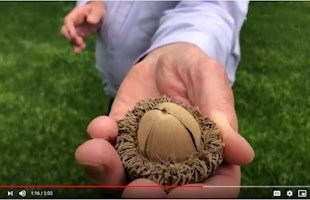
Seed Hunters
Yesterday, Dave Forehand, VP of Gardens, shared a video highlighting the bur oak. This awesome tree produces significant acorns!
Watch Dave’s video, then explore your neighborhood for acorns, and other seeds from trees. If they’re in your yard, make a collection and see if you can name all of the seeds. If they’re in someone’s else yard, draw an illustration of the seed and the tree you think it is from.
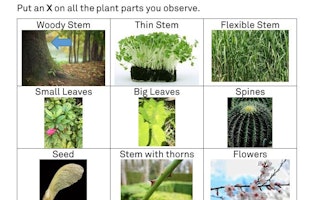
Plant Parts Hunt
Plant parts like leaves, roots, stems and fruit can look very different between different plants.
In today’s activity, you first choose one plant from your house, your yard or your neighborhood. Draw a scientific illustration and label as many parts as you can.
Then, go on a plant parts hunt to find some of the unique adaptations that leaves, roots, stems and fruit have in nature.
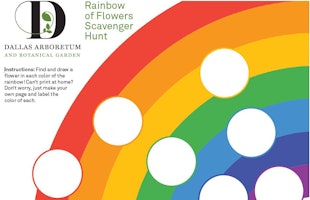
Rainbow of Flowers
Humans see a spectacular array of flower colors in the natural world!
Go on a nature walk and draw flowers (or plant leaves) that match each color of the rainbow.
Do you have any predictions which will be the easiest to find? Which will be the most difficult?
When you return home, research how other living things see color. Do bees see the same colors as we do? What about your dog or cat?

Shades of Green
Chlorophyll gives plants their green pigment, but the color of green we see can look very different. Today, we invite you to explore the varying shades of green found in plants in nature. Print the scavenger hunt linked below or create your own. You could also do a photo scavenger hunt and then arrange the photos from the lightest green to the darkest.
As you observe the shades of green, draw a sketch of each leaf. Perhaps, you can also write notes about the plant, where you found it and if you know any information about it.
If you need identification help, try iNaturalist, a free app that allows experts to help you identify things you find in nature.

Find & Draw 2
Today’s scavenger hunt will have you looking high and low! Once you complete each square, choose one of your sketches to investigate more deeply. What new scientific learnings can you uncover today?
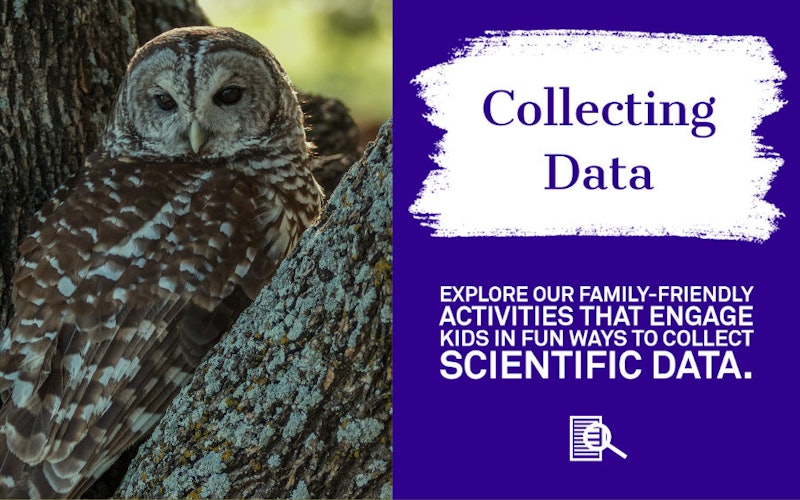

Edible Plant Parts
Humans eat an incredible variety of plants, but have you ever considered what part of a plant our favorite fruits and vegetables are? Download and print our edible plant parts sorting mat (or just make your own). Then, explore your refrigerator and pantry for foods that are plants. Decide which part of a plant each food is and add it to your sorting mat. What plant part do you eat the most? Is there a plant part that you don’t normally eat?

Sun or Shade?
We often describe a habitat as all of the elements, living and nonliving, that something needs to survive, but can a plant grow and survive without sunlight?
In today’s lesson, Sun or Shade, kids compare the growth of a seedling with and without sunlight. By collecting and comparing data using our simple data sheet, we ask students to think more deeply about plant survival.

Life Cycles
A highlight of many student’s science learning is the ability to see living specimens in their classroom. The Dallas Arboretum Education team has a number of classroom lab programs that do just that, too!
During this unprecedented time in which we can’t share these animal ambassadors with you, we’re fortunate to have academic partners like Northwest ISD.
Today, we share their Life Science Studies website, which brings insects, reptiles and chickens to you. You can even see chickens, guinea hens, turkeys and ducks hatch next week!
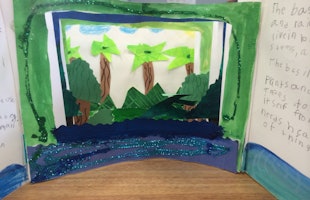
Tunnel Books
The last two months has many of us – kids and parents alike – seeing backyard nature in a whole new light. We’re observing the phases of the moon, the arrival of spring through blooming and budding plants and the life cycle of birds, butterflies and more.
Feels good, right? Today’s activity provides the perfect artistic outlet to share all of these nature observations your family has been making. Below we’ll provide the perfect template and great alternate examples of a tunnel book. A tunnel book is any book that allows the reader or viewer to see through sections a reveal a 3D world. It can make many forms. We love using it to explore life cycles (with a different stage on each panel) and patterns (like the moon phases), but your options are endless. It can even make a great 3D scrapbook for a family hike, vacation or significant event. The template we’ve provided includes optional cover pages that can be used to write about the experience that inspired the tunnel book. On the last page, we’ve provided a list of resources showing sample tunnel books from students, teachers and artists. They’re sure to inspire your tunnel book journey!
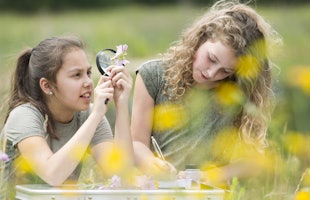
Sound Maps
When we picture our kids making observations of nature, it often looks like this image. We traditionally think about observations being what we SEE in nature, and often times, we then ask kids to record these observations as words and images. Sound mapping is an activity that encourages families to observe nature in a distinct new way: using only sounds.
Sound maps help us to focus less on what we can see and instead on intently observing the natural world around us. By downplaying the importance of sight, sound mapping actually trains participants to center their concentration on the natural world around them and they couldn’t be easier to make!
A piece of cardboard and a marker are all you need to make a sound map. You can also use a notebook or journal if you have one. Participants should mark an ‘x’ in the middle of the board and this is their location in the map. Then, for a set period of time (we recommend starting with 3-5 minutes), participants should sit quietly and listen for signs of nature around them. Then, mark their location on the map along with quick illustrations that show what was heard. If you hear a bird, do a quick sketch. How can you indicate the sound it made or where it came from? Encourage kids to provide as much information with their sketch as possible. Check out some great examples of what it could look like here. And if you’re a teacher, here is a sample lesson plan that you can share with your students and their families. A sound map is likely to inspire more questions about the natural world. How does the same spot sound at a different time of day or year? What sounds are only heard in the evening? What was that strange clicking sound I heard? Was it an insect? Can I hear it again? Perhaps, a sound map is the start of your backyard nature journal – or it may be a way to capture your favorite nature spots. Plus, you’ll have a great art piece to celebrate science learning and childhood inquiry. Happy sound mapping!

Is This My Home?
Explore habitats at home with our Is This My Home? lesson. Students and families will investigate the four elements of a habitat and compare how their habitat compares to that of a different animal and a plant.

Bee-autiful Science
What makes a drawing scientific? In today’s activity we explore how drawings and scientific illustrations are different. Follow the steps below:
- Quickly draw a bee that somone else in your family can recognize as a bee.
- Now, label all the parts.
Have you included the correct number of legs? wings? eyes? body segments? Chances are, you didn’t because some of the basics are enough to recognize a bee.What if your audience was students learning about the parts of an insect? How would your drawing change? Now, draw a second illustration focused on drawing an accurate bee. How has your illustration changed? See the link below for two examples.
Next, choose something living that you don’t know much about. Draw what you think it looks like, then do some research online and create a second scientific illustration with as much detail as possible.

Nature Changes
The time spent at home has many families observing patterns in nature such as the arrival of spring as seen through growing leaves and blooming buds, the changes in the moon phases and the life cycle of birds and butterflies.
Today, we have a template you can use to illustrate one of these patterns or cycles. It gives you four windows for illustrations and for information. Check out the student sample for the lunar cycle.
What scientific observations or natural phenomenon will you choose? We’d love to see the results!
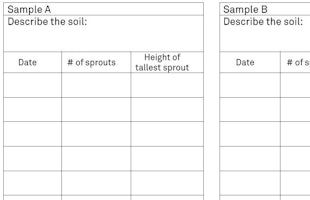
Soil Trials
Our classroom lab program, The Scoop on Soil, looks at how plants grow in different soil types. It’s essential question is: how well does a pea plant grow in different soils?
This is an activity you can easily do at home. All you need is something that will grow from your pantry or spice rack, like poppy seeds, lima beans or popcorn. Not sure if it will grow? You can do a test by placing it in a damp paper towel, inside a plastic baggie in a sunny window. If it sprouts, it will work for this at home lab.
Once you’ve selected your seed for growing, fill three cups with different soils – you can choose soil from your flower bed, your yard, a potted plant, gravel from the driveway or even kitty litter. Then, plant and water your seeds.
Use our growing chart to record your data. What do you notice about growing height? amount of water needed? the healthy look of the plant over time?
Make a log of all the questions you have as your complete the trial – it may inspire you to test another question!

Backyard Bird Ethogram
This spring we have shared several ways to document observations made in nature. Journals, photographs and scientific illustrations all help kids focus on the world around them. Today, we share another way to catalog the living world – ethograms.
An ethogram is a scientific study of an animal’s behavior. It includes all possible behaviors that an animal or group of animals could exhibit. They allow different scientists to collect and share meaningful data.
We’ve created an ethogram for backyard birds. In order to collect this data, have your child or student select a safe outdoor space that is frequented by birds. Set a collection time and duration. Then, each time a behavior is observed, mark a tally in the column. At the end of your set time, write a total for each behavior. This allows kids to rank the most frequent behaviors in a given location.Which behaviors are most common in your yard or neighborhood? What are some possible explanations? What does bird behavior look like at different times in the day in the same location? What does it look like in different locations at the same time of day? Perhaps, you can coordinate a family or neighborhood research day.
If you’d like a bit more information about ethograms, check out this guide from the Lincoln Park Zoo.
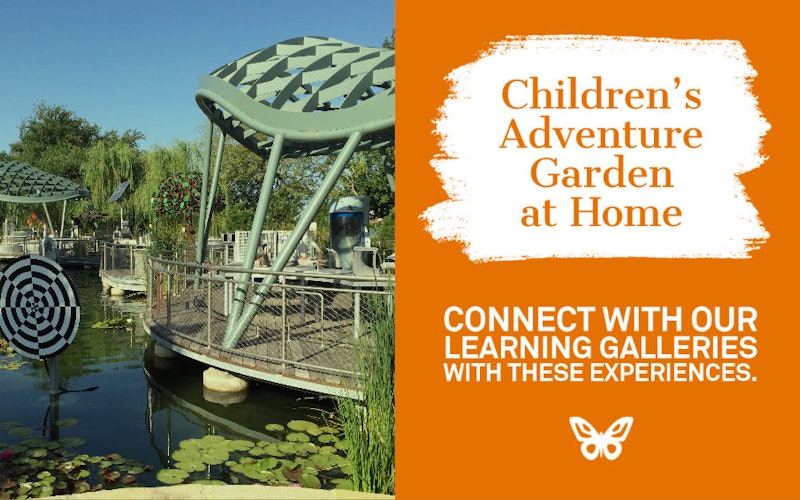

Exploring Patterns
Geometric patterns and symmetry are everywhere in nature. In today’s lesson, we encourage you and your family to explore patterns that you find in your house. You can use these patterns to test your knowledge of 2D and 3D shapes or even to create art using mathematical concepts like tessellations. Let your mind run wild – and you might even find these shapes in your yard or neighborhood. Can you go on a hexagon walk? Find squares in the kitchen? The options are endless!

Water Quality Testing
One of our signature education programs in the Children’s Adventure Garden is Texas Native Wetlands. In this program, students use high tech probeware and microscopes to explore the macroinvertebrates that call our wetlands home.
Today, join staff educator Christine as she provides an opportunity to explore water quality from home!
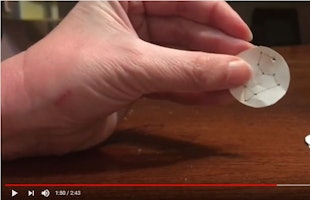
OmniGlobe
Have your evenings at home given you the opportunity to notice the night sky? Have the sunsets looked stunning? Have you seen changes in the moon?
All of these things happen everyday, but taking pause to notice them can help connect you to the natural patterns in the night sky and the world around you.
In today’s activity, education specialist Christine shows you how to make constellations to create your own night sky!
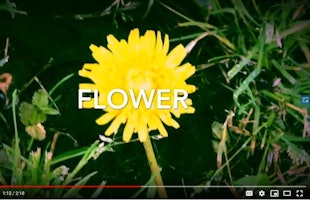
Living Cycles
Dallas Arboretum Educator Christine is back with another Children’s Adventure Garden at Home video. Today, she helps you connect with our Living Cycles learning gallery, with an outdoor exploration of the elements of a habitat.

Pure Energy
Our wildly popular Pure Energy learning gallery, in the Rory Meyers Children’s Adventure Garden, focuses on three types of alternative energy: wind, solar and water.
Explore sources of energy at home with the Dallas Arboretum education team, and you’ll never look at everyday things at home the same way!

Earth Month Challenge
Our friends at the Denver Botanic Gardens have created an Earth Month Challenge for your entire family.
See how many categories you can complete before the end of April – it can be a challenge just for you, for your family or for your besties.

Marble Run
The unifying them of the Rory Meyers Children’s Adventure Garden is the movement of water, and today it serves as our inspiration for an opportunity to explore gravity and momentum at home.
Kid’s marble runs, like the one pictured here, have been popular for decades, but you can make your own at home – and use it to engage your kids in scientific discussion!

Habitats
Educator Christine is back with another at home activity to connect with our Children’s Adventure Garden. Today, she shares our Habitats gallery with a field exploration that you can complete in any outdoor space!

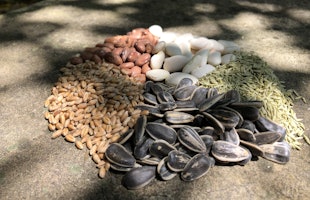
Window Greenhouse
Did you know that you already have everything you need to build your own greenhouse at home? While it may not be your plant’s forever home, this week’s lesson Window Greenhouse provides easy to follow instructions for growing seedlings in your window by using a zipper bag. Explore the refrigerator, pantry and spice rack – or raid the grass seed in the garage – and you’ll have days of fun observing plants in action, all from the safety of home!

Dream Designer
Each season, our horticulture team transforms the garden with thousands of plants highlighting seasonal color. From spring tulips to summer tropicals and fall pumpkins to winter greens, there is one thing that stays the same: a garden full of resplendent color!
Today, we invite you to dream of how you’d design the Jonsson Color Garden! First, watch VP of Gardens Dave Forehand highlight this incredible undertaking. Then, download the image of “B” Bed and either use your mobile app of choice (like Instagram Story) or print and color with marker. If you’re looking for more of a challenge, download our scale drawing of “A” Bed and put your math and design skills to work.
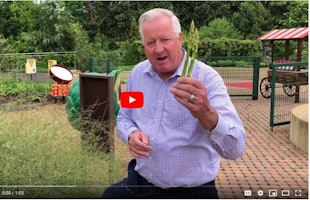
Veggie Seeds
Just like oak trees and sunflowers, many of the vegetables we eat reproduce by making seeds.
Take a look at our VP of Gardens, Dave Forehand, as he explores what the asparagus plant looks like when it goes to seed – it may surprise you!
Then, take an inventory of the vegetables in your refrigerator. Decide what part of a plant each one is. For the ones that are not fruits or seeds, research what their fruit and seed looks like!

Root of Plant Energy
We know that green leaves capture the sun’s energy and feed plants, but where do they store their energy?
In today’s activity, we visit with VP of Gardens Dave Forehand as he provides a clue to where this energy is stored on plants like tulips and daffodils.
After you watch Dave’s video, complete the activity below:
Grades K-2: make a list of all the roots that you eat
Grades 3-5: make a list of edible and non-edible plants that store energy underground like tulips
Grades 6-8: do a neighborhood walk looking for plants that probably store their energy in the same way that tulips do; illustrate and name as many as you can.

Planning Planting
Spending more time at home has many of us thinking about what we could grow and eat from home all year round.Today, we invite you to watch VP of Gardens Dave Forehand highlight a winter plant that can actually grow in your summer North Texas garden as well: swiss chard.
Then download the Texas A&M planting guide here to start planning your own home garden.
How much space do you have? Raised beds? Containers? Do you have rabbits, deer or other animals to look out for?
Start with your vegetable plan, based on the season and space available, then dream up your ideal garden!
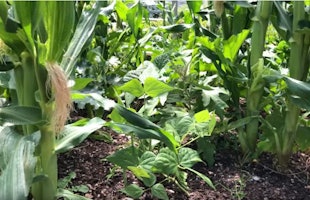
Three Sisters Garden
For many indigenous peoples from the Southwestern United States south into Central America, the three sisters garden has been a food staple for centuries – and variations now exist worldwide.
Today, VP of Gardens Dave Forehand overviews our Three Sisters demonstration garden in the Incredible Edible gallery of the Rory Meyers Children’s Adventure Garden.
After watching Dave’s video, take a look at this post that provides more detail on the science behind this method and options of how you could build your own. And it’s not too late to start one for this year!
Virtual Visit
Explore the garden from the comfort of home.